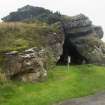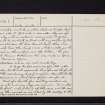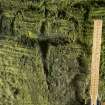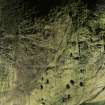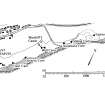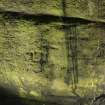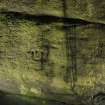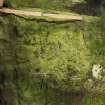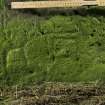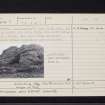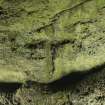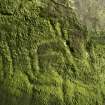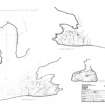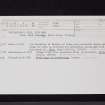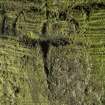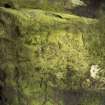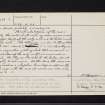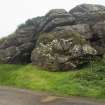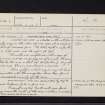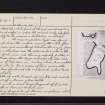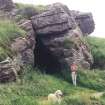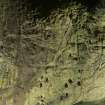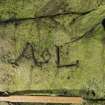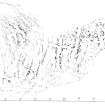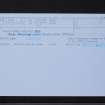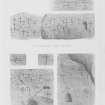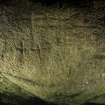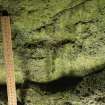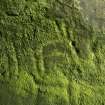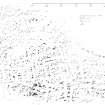Constantine's Cave, Fife Ness
Cave (Period Unassigned), Rock Carving(S) (Period Unassigned), Inorganic Material (Glass)(Roman), Unidentified Pottery (Period Unassigned)
Site Name Constantine's Cave, Fife Ness
Classification Cave (Period Unassigned), Rock Carving(S) (Period Unassigned), Inorganic Material (Glass)(Roman), Unidentified Pottery (Period Unassigned)
Canmore ID 35369
Site Number NO61SW 6
NGR NO 6327 1009
Datum OSGB36 - NGR
Permalink http://canmore.org.uk/site/35369
- Council Fife
- Parish Crail
- Former Region Fife
- Former District North East Fife
- Former County Fife
Constantine’s Cave, Fife Ness, Fife, rock carvings
Measurements:
Stone type: sandstone
Place of discovery: NO 6327 1009
Present location: in situ.
Evidence for discovery: first recorded in 1867. The cave was excavated in 1914, yielding finds of Roman date.
Present condition: fair.
Description
Stuart recorded 35 incised linear crosses on the walls of the cave, all of simple type apart from one on which a line links the side and upper arms. There are also two incised animals, but Stuart’s drawing and that of Wace and Jehu are entirely different and the latter is probably the more accurate.
Date: early medieval.
References: Stuart 1867, pl 29; Wace & Jehu 1915, 237-44.
Desk-based information compiled by A Ritchie 2017
Excavation (June 1914)
Constantine's Cave. was excavated by A G B Wace and Professor Jehu in June 1914.
A J B Wace and Prof Jehu 1915.
Field Visit (6 July 1925)
‘Constantine's Cave’.
This is a cave in the north face of a rocky crag on the shore of Fife Ness, about 300 yards north-west of Craighead farm. Its mouth is 10 feet wide, its roof approximately 12 feet above floor level, and it extends to a total depth of about 24 feet. The walls are sculptured with a series of incised crosses and two crude figures of animals. An account of the excavations carried out a few years ago, as well as particulars of the relics recovered, was published in Proc. Soc. Ant .Scot., xlix (1914-15), pp. 237-244 and 251-255.
Stone coffins, which may or may not have been connected with the occupation, have been found in the immediate vicinity of the cave. The name attached to the cave is that of Constantine II, King of Alba (903-943), who is said to have spent the remaining years of his life as a ‘Culdee’ at St. Andrews, where he became Abbot and died in 947.- Fordun's Chronica Gen. Scot., lib. iv, cap. XXIII. Wyntoun's Orygynale Cronykil, bk. vi, chap. x.
RCAHMS 1933, visited 6 July 1925.
Field Visit (15 October 1956)
NO 6327 1009. Constantine's Cave is 6m deep, 3m wide at mouth, and c.4m high, the floor being rubbish strewn. The sculptures are still traceable though indistinct and mutilated.
Visited by OS (DS) 15 October 1956.
Desk Based Assessment (1956)
NO61SW 6 6327 1009.
Name Constantine's Cave (NR).
OS 6" map, (1919).
Constantine's Cave. was excavated by A G B Wace and Professor Jehu in June 1914.
Traces of a mortar built wall were found running across the mouth of the cave and there is evidence to show that the whole front of the cave was at one time walled and roofed in where the natural rocky roof fails, probably to be used as a habitation or chapel.
The main occupation layer was found about 1ft below the surface, covering the whole floor of the cave, and consisted of black earth varying from 2 1/2 feet in thickness near the entrance to 6 inches in the middle of the cave and thinning rapidly further in.
Finds from this layer consisted of, inter alia:
1. Bones of Red deer, ox, Turbary sheep, horse, rabbit and whale. Some pieces of bone and antler had been fashioned into implements such as borers and chisels.
2. Shells of crab, limpet, periwinkle and mussel.
3. Part of a Roman glass bottle
4. Two small and one large fragment of fine red-surfaced Romano-British ware.
5. Many fragments of Roman amphorae which, when complete, must have stood about 2 1/2 to 3 feet high and were about 1ft 8 inches in diameter. They are of coarse clay with an exterior creamy slip. Only two jars could be partially restored with any certainty, but there would seem to have been at least three more. One handle bears the stamp PMSA while another jar has VD incised on the surface near the bottom. The jars are not Romano-British ware but were made in Spain, Italy, France or Africa
6. A whetstone and an iron nail 2 1/2 inches long.
A large boulder and a row of 4 slabs within the mortar built wall appears to have formed the front wall of the cave during its early occupation. Near the boulder was a depression in which traces of fire were found.
Part of a hearth for smelting ironstone was found in situ and iron slag was common. "It is clear that the first inhabitants of the cave and the iron- working then carried on are dated by the pottery to the Roman period, probably 2nd century AD."
"The next inhabitation of the cave is noted by the mortar-built wall, numerous crosses incised on the upper parts of the rocky walls and the 'Celtic' animals cut in the rock..." The latter are "similar to those that occur at East Wemyss (NT39NW 3 6-10) where they are found in conjunction with symbols that are common on the second class of the early sculptured monuments in Scotland. Thus they can be dated to the Celtic period or roughly to 800-1000 AD. At this time the cave was perhaps used as a chapel or hermitage as apparently was the case with the caves at Caiplie near Crail (see 50 NE 6)
A J B Wace and Prof Jehu 1915.
Constantine's Cave is situated in the north face of a rocky crag on the shore of Fife Ness, about 300 yards north west of Craighead farm. Its total depth is 24ft., the mouth is 10ft. wide, and the roof 12ft. high. The walls are sculptured with a series of incised crosses and two crude figuures of animals. The name attached to the cave is that of Constantine II, King of Alba (903-943).
Stone coffins which may or may not have been connected with the occupation, have been found in the immediate vicinity of the cave.
RCAHMS 1933.
Field Visit (3 September 1968)
As described by Stagg. Name "Constantine's Cave" confirmed.
Surveyed at 1/2500
Visited by OS (WDJ) 3 September 1968.
Field Visit (1996)
Site recorded by Maritime Fife during the Coastal Assessment Survey for Historic Scotland, Fife Ness to Newburgh 1996
Laser Scanning (13 November 2017 - 14 November 2017)
HES carried out a number of laser scans at Constantine's Cave to record the shape of the cave and the locations of the carvings
External Reference
Two fragments of Roman amphorae from Constantine's Cave are on display in the museum. They have no accession numbers.
Exhibits in Bell Pettigrew museum, St Andrews.









































